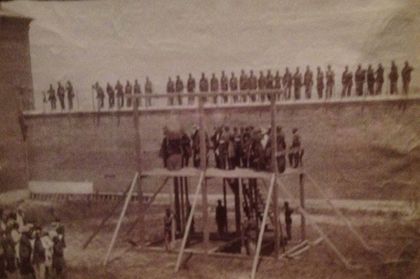Four of Booth’s Co Conspirators on the Gallows

The “Greatest Conspiracy,” financed and carried out by the Confederacy after its military defeat, has been purged from our historical memory, but it served to save white supremacy whose effects are still seen every day. See post below.
The Civil War was all but over on the battle field and the Confederacy was all but defeated. Lee surrendered to Grant at Appomattox on April 9, 1865 in the decisive battle. Richmond, the Confederate capital, fell on April 2 and Sherman was burning all before him on his way to leveling Atlanta and accepting Johnston’s surrender on April 26. The last hope of the Confederacy was an assassination plot against the leaders of the Federal Government designed to rescue some sort of victory from the ensuing chaos.
Most know of John Wilkes Booth’s assassination of President Lincoln in Ford’s Theater on April 14, five days after Lee’s surrender. But the larger Confederate assassination plot of which Booth was part has been cut out of our national memory. Ulysses S. Grant, head of the Union Army, was also targeted and scheduled to accompany Lincoln in his presidential box, but decided at the last minute to leave Washington to visit his children. Secretary of State Seward, another target, was at home, recovering from a carriage accident. He was severely wounded, narrowly escaping death when his son, a servant, and a military guard drove the would-be assassin out. Vice President Andrew Johnson escaped attack when his appointed assassin decided not carry out the assassination of the Vice President. J.W. Booth was caught in Virginia on April 26th and was fatally wounded when he refused to surrender. Eight of Booth’s co-conspirators were quickly identified and apprehended.
The details of the assassination plot were uncovered through the proceeding of the conspiracy trial held from May 2 until June 29, 1865 and were front page news in virtually every newspaper in the country at the time. Writing in 1891 about the conspiracy trial of 1865, T.M. Harris, the last surviving judge who presided over that trial, declared “that this most important event in our history has been obscured and forgotten” over the 26 years following the assassination (Assassination of Lincoln: A History Of the Great Conspiracy Trial). On trial were eight of Booth’s co-conspirators, as well as eight unindicted co-conspirators who were leaders of the Confederate government, including Confederate President Jefferson Davis, and members of the Confederate secret service. Four of the indicted co-conspirators were hanged on July 7. Three were sentenced to life in prison. One, to six years. All were pardoned, along with Jefferson Davis, by Johnson in 1868.
It was clear that Booth’s team of assassins was funded and significantly assisted by the Montreal Office of the Confederate Secret Service. Booth met with leading Montreal agents at least twice and received funds from them. He had in his room in Washington a bank book for a Montreal account and a code that was the same as the one used by Davis’s Vice President. Davis was said to have delivered a letter to a February 1865 meeting of the Montreal agents stating that assassination of the heads of the Federal government would obtain peace on better terms than might otherwise be obtained.
Harris said in 1891 not one in a thousand would know of the events revealed in the trial. It would be surprising if one in a hundred thousand today has any idea of this ugly history. This history is significant not just because it documents the broad Confederate conspiracy that led to the assassination of a great president, but because it represents the monumental failure to rid the country of centuries of white supremacy, which might have been dealt a crippling blow with the defeat of the Confederacy, but for the turn of events following Lincoln’s assassination.
Lincoln died the following morning, April 15, and his successor, Vice President Andrew Johnson was sworn in as president a few hours later. Johnson was a self-proclaimed white-supremacist from the Confederate state of Tennessee. Johnson opposed secession from the Union but was opposed to any legal protection for the emancipated slaves. He was chosen as Lincoln’s running mate on the National Union ticket in the1864 election to demonstrate to northern Democrats and the Confederate states Lincoln’s wish for conciliation at that time.
Jefferson Davis was captured in Georgia on May 10 and was imprisoned. On May 26what remained of the last Confederate force surrendered. The blood on the battlefield had not yet washed away, but a new phase of the battle was about to begin.
Three days later on May 29 the new president granted amnesty and pardon to all persons who directly or indirectly participated in the rebellion. All property rights were restored except for slaves. At the same time Johnson directed the secessionist states to hold elections and seek readmission to the Union. A large number of the newly elected were actually the former Confederate office holders re-elected to their old posts. Former Confederate congressmen were demanding positions to which they claimed their seniority entitled them. Republicans protested vehemently. Johnson supported the southerners, apparently hoping to garner enough of their support to gain the Democratic Party presidential nomination in 1868. The southern states quickly passed the “black codes” (1865-66), under which any freedman who did not have a one year contract to work for a white man was charged with “vagrancy” and imprisoned. The black codes drove former slaves back to the plantations and provided a massive supply of black convict lease labor to replace the cheap labor deficit created by freeing 4 million slaves.
Congress passed the 14th amendment granting equal protection under the law. Johnson vetoed it. Congress overrode the veto and finally achieved ratification by the necessary three fourths of the states by making readmission of the southern congressional delegations conditional on their ratification of the 14th amendment in 1868.
Southern states believed they were coerced into ratification. Grant was elected President in 1868. The Fifteenth Amendment was passed in 1870 in the hope of ensuring blacks the right to vote. Grant sent Federal troops into South Carolina to uphold the 15th Amendment and curb KKK violence. Troops were sent to other southern states as well. Democrats, the former secessionist war party, were rapidly gaining control of southern state governments by 1872. Grant was re-elected for a second term that year but the Republican Party had split and northern enthusiasm for reconstruction had waned.
When the deal was struck to give Republican Rutherford B Hayes the Presidency in the contested 1876 election in exchange for his removing the last federal troops from the South and solidifying the rule of the white supremacists and the property relationships on which the Old South was built, the gains achieved in the brief period of reconstruction disappeared overnight. The New Order was Jim Crow and its enforcers, the Ku Klux Klan. It continued without hindrance for the next ninety years.
In 1965, when the last Voting Rights Act was passed, only 7% of African Americans in southern states were able to vote. Today millions of ex-felons, black and Hispanic, imprisoned for non-violent drug law violations, have lost their vote, access to housing, food stamps and jobs. Many millions of others are losing their vote with new voter identification laws, to say nothing of nine hour lines at polling places in minority districts. Institutionalized racism in separate and vastly unequal schools is endemic.
With white supremacy so imbedded in our institutions, in what can only be called “The New Jim Crow,” we cannot allow this history, and the understanding of our society that comes with knowing it, to continue to be hidden from us.
Abraham Lincoln said “history that is not true is not history.” It’s propaganda.


